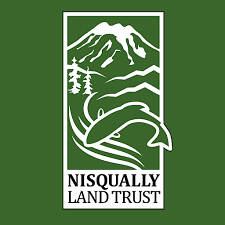An environmentalist, a mental health advocate and a politician walk into a wine bar…
It might sound like the beginning of a funny story, but it actually happened.
On Nov. 14, Jeanette Dorner, Nisqually Land Trust executive director; Greg Nance, Run Far Foundation founder; and former congressman Don Bonker met with friends at the Rolling Bay Winery to talk about developing opportunities for youth to create community projects in the Nisqually River Watershed to benefit, salmon and wildlife around Bainbridge Island.
Inspired by the experience of raising salmon in middle school, Nance shared his experiences with the group.
“We had the chance to actually raise salmon eggs in a tank at Sakai Intermediate School in my science classroom where we learned about the life cycle of salmon and then took those eggs down to the river behind our school, and actually helped the salmon to spawn.
“And every four years these salmon come back up Murden Cove, where I live on the island, and then they go spawn in the stream. I have a passion for conservation and for taking care of the environment that didn’t just come out of nowhere; it came out of these wonderful experiences that fell into my lap.”
Nance, who advocates for youth mental health, sees an opportunity for teens to be part of something greater than themselves as they face daily challenges.
“If they have a community, they have a purpose, and they’re going to be so much stronger and more resilient,” said Nance, whose foundation is giving young people grants to create community-based projects.
Dorner hadn’t heard of Nance until he ran 85 miles from Puget Sound to Mount Rainier in two days and set a world record by running the length of the protected lands along the Nisqually River watershed. That inspired her to partner with the Run Far Foundation.
“We’re very fortunate in that both our headwaters at the mouth of the river are already in federally protected lands. So the work of the land trust as a nonprofit, is to work on the in-between to try and connect all those pieces,” Dorner said.
In 1989, only 3% of the main stem shoreline with salmon usage was in protected ownership. Today, 78% is protected by the land trust, which now owns 14 miles of shoreline.
“The big focus is on salmon, but when we protect these habitats, we’re protecting it for other wildlife as well,” said Dorner who showed pictures of elk on the shorelines. Dorner worked as the Salmon Recovery program manager for the Nisqually Tribe for nearly 12 years.
Of Nance’s mission, Bonker said, “It gives the young people a purpose in their life, and what could be better than working in what I call nature’s cathedral.”
Nance said this effort has been going on for a long time.
“A group of very, very dedicated civic and environmental leaders have been making this happen since I was a baby, and before that our indigenous partners, since time immemorial, have been taking care of this wonderful ecosystem and salmon highway.”
For details
Go to Nisquallylandtrust.org/how-to-help/ and start a project at Runfarfoundation.com/apply.



